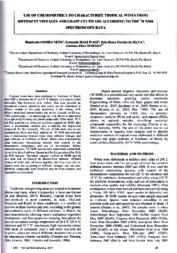Use of chemometrics to characterize tropical wines from different vintages and grape cultivars according to the 1H NMR spectroscopy data.
Use of chemometrics to characterize tropical wines from different vintages and grape cultivars according to the 1H NMR spectroscopy data.
Author(s): GOMES NETO, H.; HALLWASS, F.; SILVA, J. B. P. da; PEREIRA, G. E.
Publication year: 2011
Types of publication: Paper in annals and proceedings
Unit: Embrapa Grape & Wine
Keywords: Análise química, Enologia, Espectroscopia, Quimiometria, Uva, Variedade, Vinho, Vinho tropical
Observation
Some of Embrapa's publications are published as ePub files. To read them, use or download one of the following free software options to your computer or mobile device. Android: Google Play Books; IOS: iBooks; Windows and Linux: Calibre.
Access other publications
Access the Agricultural Research Database (BDPA) to consult Embrapa's full library collection and records.
Visit Embrapa Bookstore to purchase books and other publications sold by Embrapa.

